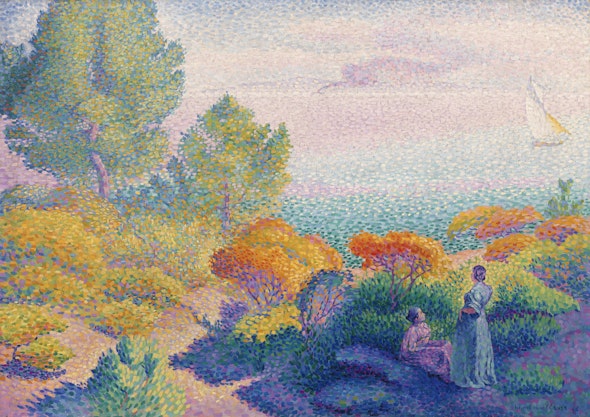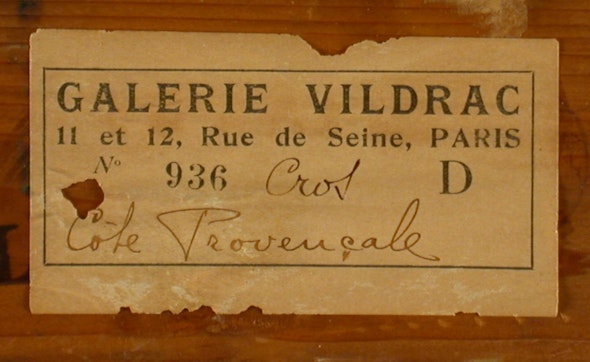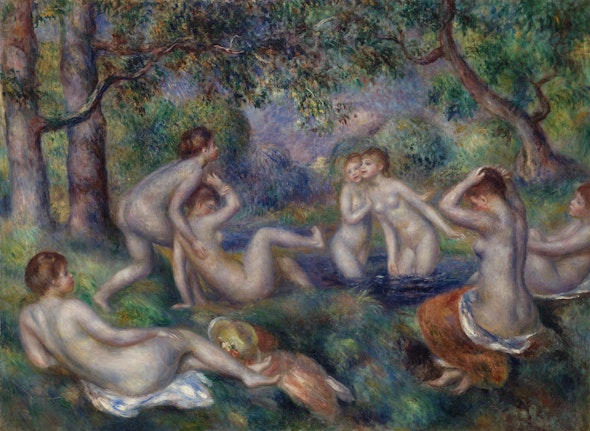Henri Edmond Cross. Two Women by the Shore, Mediterranean (detail), 1896. BF436. Public Domain.
“I Would like to Paint Happiness”:
Henri-Edmond Cross's Two Women by the Shore, Mediterranean
By Amy Gillette, PhD, collections research associate
Two Women by the Shore, Mediterranean (BF436) is an iridescent seascape of the Provençal coast of France (Fig. 1). A label on the painting’s stretcher identifies the landscape as “Côte Provençale” (Fig. 2); the specific site is probably the Plage de Saint-Clair on the Côte d’Azur, the adopted home of artist Henri-Edmond Cross (1856–1910). Green-and-gold trees and brush rim the beach, casting purple shadows. The sea and sky merge in hazy bands of lilac, lavender, and aqua. The composition is further enlivened by the “self-perpetuating energy” of arabesque curves in the trees and hills.¹ A sailboat, highlighted with sunshine-yellow, wafts into view from the right; in the distance, we see a low purple mountain and a trail of smoke from a passing steamship. In the lower right corner, a standing woman gazes toward the sea, and a sitting woman faces her. They both wear long dresses and seem to be talking with each other.

Fig. 1. Henri Edmond Cross. Two Women by the Shore, Mediterranean, 1896

Fig. 2. The label on the painting’s stretcher
About the Artist
Cross was from Douai, France, and had studied painting at the Écoles Académiques de Dessin et d’Architecture in Lille.² His professional career truly launched when he moved to Paris in 1881. In 1884, he cofounded the Société des Artistes Indépendants with a collective of other avant-garde artists, including Georges Seurat (1859–1891), Paul Signac (1863–1935), and Odilon Redon (1840–1916), all of whose works are displayed in the Barnes collection. They organized the annual Salon des Indépendants as an alternative to the rigid academicism of the government-sponsored Salon. In 1891, Cross formally joined the neoimpressionist movement. Neoimpressionism, generally, involved using juxtaposing tiny dots of contrasting or complementary colors to achieve a harmonious composition.³

Fig. 3. Georges Seurat. Models, 1886–88. BF811. Public Domain.

Fig. 4. Detail of the south wall ensemble in Room 18. © The Barnes Foundation
Also in 1891, Seurat died prematurely, and Cross moved to Cabasson on the Côte d’Azur with his partner, Irma Clare. In 1893 they married and settled in Saint-Clair.⁴ Signac meanwhile moved to nearby Saint-Tropez.⁵ Responding to their new Mediterranean environs, the two artists proceeded to develop a “second school” of neoimpressionism focused on brilliant light and strident color, and articulated with mosaic-like brushstrokes that are larger and looser than the granular pointillism they’d practiced in Paris. You can see the distinction by comparing Two Women by the Shore with Seurat’s Models (1886–88) (Fig. 3).⁶ Cross’s friendship with Signac, and their ongoing dedication to the progressive principles they’d established with their colleagues in Paris, is memorialized in Room 18 of the Barnes, where Two Women by the Shore is displayed next to Signac’s watercolor cityscapes Rouen and Geneva (Fig. 4). Their experiments enticed other like-minded artists to sojourn at their homes; fellow neoimpressionists Maximilien Luce and Théo van Rysselberghe were frequent guests. Notably, Henri Matisse visited in 1904 and was moved by Cross’s L’air du soir (1893–94; Musée d’Orsay) to paint his breakthrough work Luxe, calme, et volupté (1904; Musée d’Orsay).
Neoimpressionism, Social Justice, and Science
Let’s now consider the meaning of Two Women by the Shore. Viewers might initially suppose that the image presents a nostalgic or timeless utopia of people and nature at peace, perhaps comparable with some of Renoir’s sylvan bathing scenes, for example, his near-contemporaneous Bathers in the Forest, c. 1897 (Fig. 5). But Cross’s allusions to modern life—the steamship, the fashionable dresses—signal the need to look and think further.⁷ The women’s well-covered (as opposed to uncovered) bodies serve less to stimulate the viewer’s sensual pleasure than invite them to consider the material and symbolic roles of human beings within a neoimpressionist composition. Cross, in fact, explicitly looked forward to a future anarchist civilization.⁸ He wrote to Signac in 1893, while working on Evening Air, “I would like to paint happiness. The happy beings that men may be in a few centuries (?) when pure anarchy will be achieved; but, not being up to it, I content myself with making a lot of sketches leading toward this result: sinuous lines of women amid the verticality of pines.”⁹

Fig. 5. Pierre-Auguste Renoir. Bathers in the Forest, c. 1897. BF901. Public Domain.
Are you surprised that Cross’s placid rainbow seascape is a forecast of anarchism? Politics were actually inherent in the neoimpressionism movement. It was born during an especially turbulent period of French history, when industrial capitalism was overhauling the nation’s economy and cultural geography.¹⁰ Anarchism seemed to present a compelling salve for the rampant upheavals.¹¹ A variant termed anarcho-communism was formulated between the 1870s and 1890s by thinkers including Jean Grave, Pierre Kropotkin, Elisée Reclus, and Félix Fénéon, who advocated a combination of individual freedom and collective ownership of the means of production. They also provided ideological and material support for the neoimpressionists; Fénéon even gave the group their name.¹² Thus like the anarcho-communist political ideal, the holistic composition of Two Women by the Shore transfigures discrete color particles into a vision of beauty and peace. Cross explained his own technique according to this principle: “When one has conceived of the ensemble, study separately each fragment, then the details of each fragment, finally the details of each detail, in order finally to foresee as far as possible how each detail is itself a pretty thing.”¹³
Furthermore, emergent work in the field of chemistry helped neoimpressionists and anarchists to clarify their techniques and goals. Both movements evoked the chemical process of synthesis, whereby autonomous atoms react to each other and combine to form a new compound substance. The chemist Marcellin Berthelot recognized the humanistic potential of this phenomenon, stating in his book Science et philosophie (1886) that science has two facets: a positivistic one concerned with “directly observable relations,” and an idealistic one “led by an invincible force to construct and imagine . . . systems based not only on the consideration of matter, but invoking at the same time moral and intellectual notions.”¹⁴ Signac nearly echoed Berthelot in identifying the facets of neoimpressionism: “A Neoimpressionist work . . . thanks to its constant observation of contrast, its rational composition, and its aesthetic language of colors, includes a general harmony and a moral harmony.”¹⁵ Later, Signac remarked succinctly of neoimpressionism’s idealistic side: “Justice in sociology, harmony in art: same thing.”
The Verticality of Pines
To further explore the “moral and intellectual notions” in Cross’s Two Women by the Shore, let’s return to the artist’s comment about depicting “the verticality of pines” as a means of progress toward painting happiness. The trees and other forms of vegetal life in Cross’s paintings, though usually overlooked, are an active part of his iconography. Notice how trees and shrubs fill nearly half of the picture space in Two Women by the Shore. The tall, stately green trees toward the left of the painting are maritime pines and the gently swaying orange ones are umbrella pines (Fig. 6).¹⁶ Cross seems to have painted these trees from direct and deliberate observation, rather than schematically or as an afterthought. During the same year that he painted Two Women by the Shore, Cross notably translated the English critic John Ruskin’s The Elements of Drawing (1857): a primer for depicting the world patiently and honestly, so that aspiring artists “might see greater beauties than they had hitherto seen in nature and in art, and thereby gain more pleasure in life.”¹⁷

Fig. 6. Detail of trees in Two Women by the Shore
Cross’s attention to trees—along with other flora, the sea, and the sky—would have been consistent with anarchist thought. French anarchists even believed that the Mediterranean coast was an ideal cradle for the anarchist society of the future, because the sunshine and the harmoniously balanced elements (geographic and meteorological) were models of well-being for individuals and society.¹⁸ Perhaps Cross amplified these effects in Two Women by the Shore by representing them in a decorative mode, in line with Ruskin’s coordination of beauty with pleasure, morality, and the observation of nature. Cross’s many paintings, drawings, and letters further attest to the importance of trees and flowers in his personal vision of happiness. He thoughtfully depicted specific species of plants throughout his career.¹⁹ In praising his Provençal environs, he described mimosas, eucalyptus, almond blossoms, and “hills covered in pines and cork-oaks [that] gently die away into the sea.”²⁰ A note to Signac celebrated his own garden: “My tiny dining room is a joy. Adorned with roses picked from the hedge opposite, and branches from the strawberry tree, with red, orange and yellow fruit, like the pompoms of the Basque drummers on the Plaza.”²¹
The Philosopher’s Plant
Altogether, Cross’s trees are individual agents—within the mosaic of Two Women by the Shore—in helping people to “see greater beauties . . . in nature and in art, and thereby gain more pleasure in life,” partly now and partly in anticipation of a better world. Perhaps they can also help us to engage with Cross’s vision. Dr. Albert C. Barnes believed that learning to see the ways in which artists transform fragments of their experience into works of art engenders a more examined and sensitive life for the viewer. Twenty-first-century viewers of Two Women by the Shore will, by necessity of experience, have a different perspective on anarchism, communism, and/or their combination than Cross did back in 1896; however, most of us still share his interests in nature, happiness, and harmony. As it happens, anarchist aesthetics anticipate aspects of recent thinking about vegetal life and its potential as a lens for understanding human life. In his book The Philosopher’s Plant (2014), for example, Michael Marder argues that plant life troubles traditional orders of metaphysics: plants persistently change rather than having a stable identity, and they aren’t identifiable as individuals because of the ways in which they can propagate; these properties erode boundaries between the one and the many, and life and death.²² Marder remarks that this kind of life is a good model for a transhuman community of being with nature. Perhaps, taken in these terms, Two Women by the Shore projects a version of well-being that speaks to postmodern existence.
Endnotes
¹ For theories about the decorative form of the arabesque (and about color), see Starr Figura, Isabelle Cahn, and Philippe Peltier, Félix Fénéon: The Anarchist and the Avant-Garde, exh. cat. (New York: Museum of Modern Art, 2020), 61–63.
² The artist’s mother, Fanny Woollett, was English; his father, Alcide Delacroix, was an adventurer who came from a family of ironmongers. Henri-Edmond anglicized his surname to Cross when he moved to Paris, to distinguish himself from the famous Romantic painter Eugène Delacroix. “Henri Edmond Cross,” in The Grove Dictionary of Art from Monet to Cézanne (New York: St. Martin’s Press, 2000).
³ For neoimpressionism: Paul Signac, From Eugene Delacroix to Neo-Impressionism, ed. F. Cachin (Paris, 1964); John G. Hutton, Neo-Impressionism and the Search for Solid Ground: Art, Science, and Anarchism in Fin-de-Siècle France (Baton Rouge, LA: Louisiana State University Press, 1994); Robyn Roslak, Neo-Impressionism and Anarchism in Fin-de-Siecle France: Painting, Politics and Landscape (Aldershot: Ashgate, 2007); Cross and Neo-Impressionism: From Seurat to Matisse, exh. cat. (Hazan: Musée Marmottan Monet, 2011); Russell T. Clement and Annick Houzé, Neo-Impressionist Painters: A Sourcebook on Georges Seurat, Camille Pissarro, Paul Signac, Théo van Rysselberghe, Henri Edmond Cross, Charles Angrand, Maximilien Luce, and Albert Dubois-Pillet (Westport, CT: Greenwood Press, 1999).
⁴ Fréderic Frank et al., eds., Color and Light: The Neoimpressionist Henri Edmond Cross, exh. cat. (Munich: Prestel, 2018), 242.
⁵ Cross remained in Saint-Clair for the rest of his life, except for yearly exhibitions at the Salon des Indépendants in Paris, trips to Italy in 1903 and 1906, and several salons of Libre Esthétique in Brussels. “Henri-Edmond Cross” in The Grove Dictionary of Art from Monet to Cézanne.
⁶ The works of Luce and Pierre Bonnard were important inspirations for Cross and Signac’s “second school” developments. Henri Edmond Cross and Neoimpressionism 2011, 6. Cf. Dr. Barnes’s declaration, “Modern painting developed out of mosaics,” in The Art in Painting, 1st edition (Merion, PA, 1925), 139.
⁷ See Roslak 2007, 160–2.
⁸ As evidence of Cross’s support of anarchism: in 1896 he created an illustration, The Wanderer (L’errant), for Les Temps Nouveaux. The protagonist has a vision where workers throw a flag, a crown, and probably other insignia of capitalism/authority into a bonfire: https://theanarchistlibrary.org/library/allan-antliff-anarchy-neo-impressionism-and-utopia. Here is a lithograph of L’errant at the Philadelphia Museum of Art: https://philamuseum.org/collection/object/209991. Also see correspondence by Cross in Robert L. Herbert and Eugenia W. Herbert, “Artists and Anarchism: Unpublished Letters of Pissarro, Signac, and Others, I and II,” in The Burlington Magazine 102: 692, 693 (1960): 472–82, 517–82.
⁹ Qtd. in Monique Nonne, Henri-Edmond Cross, 1856–1910 (Paris: Somology, 1998), 110. Also Color and Light 2018, 94, citing a letter from Henri-Edmond Cross to Paul Signac, June 8, 1893 (Archives Signac).
¹⁰ Zamani in Color and Light 2018, 27. Also see pp. 13f. in Cross and Neoimpressionism from Seurat to Matisse.
¹¹ “The anarchist movement in France in the last quarter of the nineteenth century was a combination of political practice and social theory, the joint goal of which was to overthrow the existing state and the hierarchical society surrounding it and establish instead a decentralized, non-authoritarian socio-economic order.” Roslak, “The Politics of Aesthetic Harmony: Neoimpressionism, Science, and Anarchism,” The Art Bulletin 73.3 (1991): 383.
¹² See Félix Fénéon: The Anarchist and the Avant-Garde 2020.
¹³ Qtd. in Roslak 1991, 387–88.
¹⁴ Qtd. in Roslak 1991, 388, from Berthelot, Science et philosophie (Paris: C. Lévy, 1886), 64.
¹⁵ Translated from Paul Signac, D’Eugène Delacroix au néo-impressionisme (Paris, 1899), ed. Françoise Cachin (Paris: Hermann, 1964), 104.
¹⁶ Here is a guide to the trees of Provence: https://www.beyond.fr/flora/indext.html.
¹⁷ See The Elements of Drawing: John Ruskin’s Teaching Collection at Oxford: http://ruskin.ashmolean.org/.
¹⁸ Roslak, Scientific Aesthetics and the Aestheticized Earth: The Parallel Vision of the Neo-Impressionist Landscape and Anarcho-Communist Social Theory, PhD diss. (Los Angeles: UCLA, 1987), 298.
¹⁹ Rose Garden in Monaco (1884) depicts rosebushes, of course, and also a peony plant and a lemon tree. A large cork oak bends in a steep arc across Landscape with Goats (1895). A small painting titled Fleurs (Sotheby’s) shows two yellow daffodils, a white rose, a fading pink tulip, and lilacs. At the Galerie Berès, Paris, are small undated paintings of thistles and a poppy: see https://www.galerieberes.com/artiste_beres/cross-henri-edmond/.
²⁰ Color and Light 2018, 233–34.
²¹ Letter from Cross to Signac, 1891, quoted by Raphael Dupouy, “The Most Beautiful Region in the World: Henri-Edmond Cross and Le Lavandou,” in Color and Light 2018, 230.
²² Michael Marder, The Philosopher’s Plant (New York: Columbia University Press, 2014).
